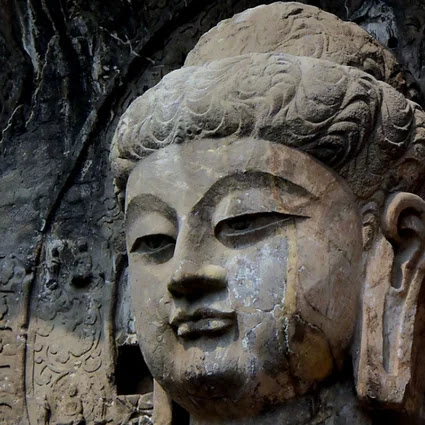B. Meenakshi Sundaram
https://simplicity.in/coimbatore/english/article/1260/

The sphinx, a mythological creature with a lion’s body and a human head, an important image in Egyptian and Greek art and legend, is known for its riddles. It devoured a man each time whenever the riddle was answered incorrectly. On an occasion, the creature posed a question to Oedipus, the king of Thebes, who unwittingly killed his father and married his mother in Greek mythology.
"What is the creature that walks on four legs in the morning, two legs at noon, and three in the evening?”
When the wise king gave the correct answer, the creature accepted its defeat and killed itself. The answer given by king Oedipus was ‘man’. Because as a child, man crawls using the hands too as legs, later walks upright with two legs and finally leans on a stick in old age!
It is surprising to know that the sphinx was found in the ancient Tamil land too but as an image. As read from an article carried in Sasanam, a bilingual magazine edited by writer Sukavana Murugan, the KCHR (Kerala Council for Historical Research), at Pattanam in Ernakulam district, stumbled upon a seal-ring with the carving of the sphinx. The gem with the intaglio of the sphinx bears testimony to the maritime trade relations between the ancient Tamil land and Rome.
“Musiri, an ancient harbour, which is mentioned in various pieces of classical Tamil literature, was once a busy trade centre between Rome and the ancient Tamil Nadu. Musiri, which is said to have been engulfed by the sea, could be the town Pattanam in the present-day Ernakulam district, with many archaeological discoveries throwing light on the trade ties between Rome and the ancient Tamil land” writes Senaani in the article titled “Rome Pattanathu Mothirakkal” in Sasanam.
Substantiating the point, the writer cites the lines from the 149th song of Agananuru, a Sangam period work, which describes the arrival of the ships of the yavanas (A generic term for people coming from the west: Romila Thapar) loaded with gold at Musiri and returned with pepper. The song in Agananuru, as read from Vaidehi Herbert’s English translation, informs that the yavanas bought pepper from the ancient Tamils by paying them in gold!
….prosperous Musiri town of Cheran, where, causing the
huge, beautiful Sulli river’s white foam to become
muddied, the fine ships of the Yavanas come with gold
and leave with pepper,….
The article in Sasanam traces the possibilities of how the gemstone, incised with the image of the sphinx came to Pattanam. The writer informs that the first Roman Emperor Augustus Caesar declared himself the son of the Greco-Roman god Apollo. With his love for Greek mythology, Augustus wore the ring with the intaglio of the sphinx and had the same image as his official imperial seal.
“The merchants from Ancient Rome too loved wearing such rings and one of them must have come to Musiri, “says the article in Sasanam.
Besides carrying several stories on archaeological interest, the magazine places an accent on the recent discovery of a rare stone inscription at Kinnimangalam near Chekanurani in the Madurai district.
The inscription, discovered amid a heap of stones by a team of history enthusiasts T.K Gandhirajan, C. Raja Vel, and Ananthan Sannasi at the Ekanathar Anandavalli Amman Koyil in Kinnimangalam a few months ago, drops a hint on how the traditional ancestor worship, in course of time, gets converted into a worship of gods in the established religion.
The article ‘Varalatril Kinimangalam’ (Kinnimangalam in history) penned by Su. Rajavelu, a professor of History at Alagappa University, proves with sufficient substantiations that the two-lined Thamizhi (Tamil-Brahmi) inscription ‘Ekan Aathan Kottam’ dates back to 2nd century B.C.
“Of the different meanings of ‘Kottam’, the word also means a sepulcher cum temple constructed in memory of the dead. Manimekalai, which is one of the two great Tamil epics, describes the place Sakkaravalakottam as a ‘Kottam’ for constructing memorials for the dead. Hence, the meaning of the inscription ‘Ekan Aathan Kottam’ was a place where a sepulcher had been constructed in memory of one called Aathan, who was the son of Ekan” explains Su.Rajavelu.
The writer proves his point from another stone inscription he stumbled upon in the same shrine. The inscription, which dates back between the 7th and 8th century A.D, is the first-ever one to mention the phrase ‘Pallipatai’, whose meaning is ‘sepulcher temple’. The text on the stone “Iraiyiliyaga Ekanatan Pallippatai Mandrali Eenthaar” throws light on a donation made to the ‘sepulcher temple’ at a later period.
Searching further support for his views, the historian collected some of the palm leaf manuscripts preserved for ages in the shrine and was surprised to say they were the first-ever ones to be discovered as written in Tamil vattezhuthu (Rounded alphabet). He researched the songs written on the palm leaves and sought the opinion of the Coimbatore-based eminent epigraphist Prof Y.Subbarayalu, who, after researching, said that the songs on the palm leaf manuscripts could be the ones that had been sung in the prayers to the dead.
Besides, the magazine contains a detailed report by K.Amarnath Ramakrishna on the Keezhadi Excavation. A noted archaeologist, Amarnath is with the ASI (Archaeological Survey of India) and the one who led a team to excavate Keezhadi in the Sivaganga district.
The editorial team of the archaeological magazine Sasanam includes R.Poongundran, S.Rajavelu, V.K.Shanmugam I.A.S, Veeraraghavan, B.Devendra Boopathy, S.Paranthaman, K.A. Manoharan and P.Kumar.
The contributors to the current issue are Morthegai, J.Sounthirarajan, Mangai Ragavan, C.Veeraragavan, Sriraman, J.R. Sivaramakrishnan, S.Rajagopal, Kalsi Kumar, Ramesh, Paranthaman, Anbumani, Sai Sravan, Balaji Ravirajan, B.Sasisekaran, B.Ragunatha Rao, Aaragalur Pon. Venkatesan, Saami, Saravana Manian, Aravind. M (Translation from Asko Parpola), K.Sridaran, Kumaravel Ramasamy, Gopalakrishnan, Joseph Prabhakar, Mathivanan Balasundaram, Artist Manuvannan, and A.Prabhu.

